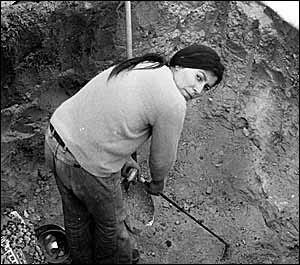
American Indian Movement activist Anna Mae Pictou-Aquash is seen in this photo on the Pine Ridge Reservation in South Dakota. Photo © KM/SIPA Press
Shawn Hendricks, the author of The Unquiet Grave: The FBI and the Struggle for the Soul of Indian Country
I once wrote that if there was a hell, it must have an endowed wing for the press of South Dakota. That was only because our nation’s paper of record, printer of all the news that The Establishment sees fit to print, already had hell’s main building. For my money, the most recent infernal sin of the New York Times was an article in its magazine on the 1976 murder of Anna Mae Aquash, an activist of the American Indian Movement. The reporter, Eric Konigsberg, condemned the AIM members who were involved in the killing, as well he should have, but let the federal government off the hook for their mighty role in the murder, which was journalistically unpardonable. I don’t know whether Konigsberg is a naïf or a tool of the feds—in a way it hardly matters. What matters is that for decades the feds in general and the FBI in particular have not only gotten away with their part in sabotaging the movement for Indian rights but in recent years have reaped a mound of favorable press from their sorry history. Thanks to the likes of Konigsberg and the uncritical-as-usual editors at the Times, the proud tradition goes on. Here are the facts: In the winter of 1973, activists of the American Indian Movement seized the hamlet of Wounded Knee and held it for 71 days against all-comers. In addition to its historic symbolism, they chose Wounded Knee because it was on the Pine Ridge Indian Reservation, whose woes were many. Pine Ridge was governed by a corrupt tribal council that ran the place for the benefit of people who profiteered off the desperately poor Lakotas. The exploiters were chiefly whites and the minority of Indians who had married into white families. Some of them were businesspeople who charged exorbitant rates in remote reservation communities for everything from peas to propane. Some were farmers and ranchers who leased land from the tribe for the merest fraction of what it was worth (the Cliven Bundys of Pine Ridge). And some were politicians and bureaucrats, a semi-nepotistic network that rigged elections and made sure that government jobs—the main source of work on Pine Ridge and nearly the only source of decently paid work—went to sell-outs and keep-your-head-down types who didn’t buck the degenerate system. AIM also chose Pine Ridge because it was in the shadow of the Black Hills, which, of course, were stolen from Indians in so villainous a breach of treaty that even a federal appeals court concluded, “A more ripe and rank case of dishonorable dealing will never, in all probability, be found in our history.” The Supreme Court upheld the ruling—but refused to give even a smidgen of the hills back, which outrages Indians to this day. Pine Ridge, of course, was merely emblematic. The wreckage there was mirrored on nearly all of the hundreds of reservations throughout Indian Country. This, naturally, was pretty much how the federal government wanted it. Good folk, hard-working folk, non-welfare-sponging folk, pioneering folk—white folk—were making money off Indian land and on Indian backs, so who could get excited if the result was that Pine Ridge was the poorest slum in America, poorer than the worst barrios of Compton or the Bronx or the South Side. So when AIM declared it was taking back Wounded Knee, with an eye to taking back more and righting centuries of wrongs, the feds responded as though South Dakota had been invaded by Red China. They sent in paramilitary units of the U.S. Marshals. They sent in armed-to-the-fangs FBI agents. They sent in cops of the Bureau of Indian Affairs and officers of the Border Patrol. They even, covertly, sent in the U.S. Army and Air Force, in violation of the Posse Comitatus Act, which prohibited the use of the military on American soil. The state of South Dakota, which had no jurisdiction on Pine Ridge, sent some troopers to buttress the cordon around the village. And Pine Ridge’s thug of a tribal chairman, Dick Wilson, gathered an illegal goon squad, paid them with money skimmed from government coffers, and worked fist-in-glove with the feds, who didn’t care about so small a thing as illegal vigilantism when there were activists at Wounded Knee to quash.Get the Story:
Steven Hendricks: The Ghost of Anna Mae (Counterpunch 5/9)
Related Stories
New York Times magazine
runs feature on Anna Mae Aquash (04/25)
Join the Conversation
